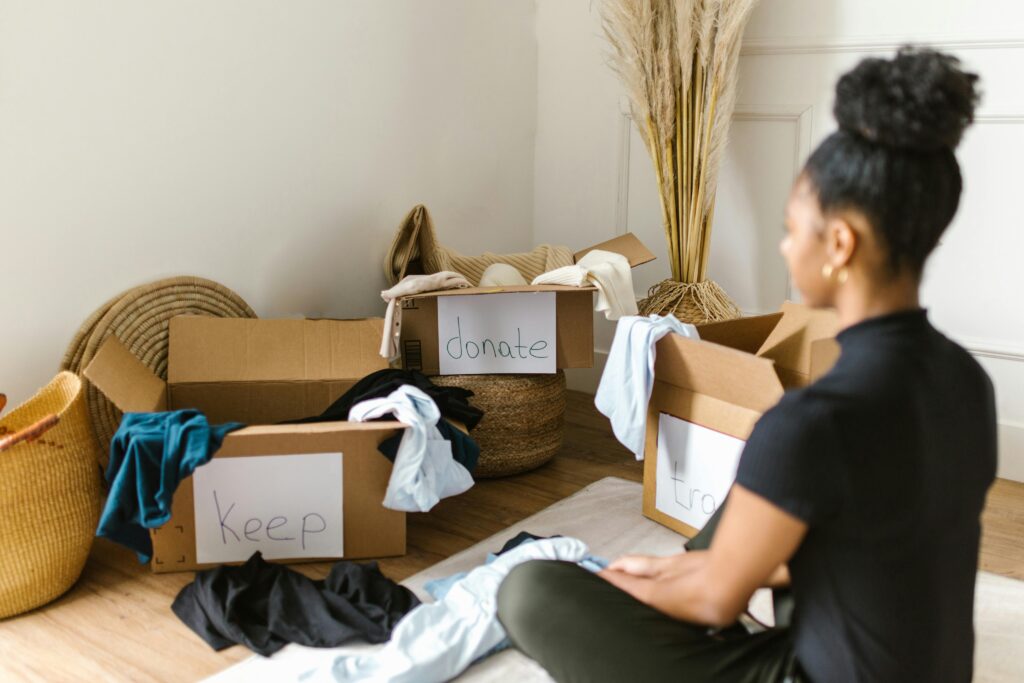Moving often brings excitement but also creates tough decisions. Packing every single thing only adds stress and costs. Still, the real challenge is deciding what to keep and what to let go of before a move. Every item requires space, time, and money to transport, so choosing wisely is crucial. Thinking carefully about belongings turns the moving process into a chance for a new start. Fewer boxes mean lighter loads and fewer worries. By sorting with intention, it becomes easier to focus on what adds real value to daily life.
The Psychology Behind Letting Go
Moving often stirs emotions because objects hold memories and comfort. Holding on feels safe, yet clutter creates stress and limits progress. Many people search for effective methods for decluttering their homes because they feel weighed down by excess. Deciding with intention helps reduce anxiety and increases clarity during a transition. Each item should support daily life instead of blocking new experiences. When belongings no longer serve a purpose, releasing them creates space for growth. By understanding these emotions, it becomes easier to separate true value from unnecessary weight and start fresh with confidence.

Start With a Realistic Timeline
Planning early prevents stress and wasted energy. A clear schedule provides structure and keeps progress consistent. Begin with small steps, then expand each week toward larger spaces. Sorting a few items daily feels manageable and builds momentum. Early preparation allows flexibility when unexpected tasks appear. Without a timeline, clutter decisions pile up and create frustration. Break the process into weeks, focusing on one room or category at a time. Regular progress builds confidence and keeps motivation strong. A steady pace leads to smoother transitions and less pressure when moving day finally arrives.
Take Inventory of Belongings
Listing possessions provides clarity and highlights what matters most. An organized record prevents confusion and saves time later. Use a notebook or digital tool to track categories like furniture, clothes, and kitchen items. While sorting and preparing for the move, remember to clean your home because dust and clutter often hide behind stacked belongings. Wiping surfaces and vacuuming corners gives a clearer view of the space. Fresh surroundings improve focus and make decisions easier. Cleaning during packing also prevents carrying dirt to the next location. A tidy environment feels lighter and more manageable. With everything documented and refreshed, the process feels less
overwhelming. Each step uncovers which objects deserve space in the next chapter. Careful attention now prevents regrets later, while also reducing stress during the move.
Measure Usefulness and Space
Practical choices save time and money during a move. Therefore, you should ask if each item still serves a daily purpose. Then compare its size with the available space in the new location. This step reveals what fits comfortably and what feels burdensome. To stay organized, decide what to keep and what to let go of before a move. Oversized furniture or rarely used appliances often create more stress than value. By weighing both function and fit, belongings become easier to evaluate. Smart planning builds a balanced living space without unnecessary clutter. To your moving checklist, make sure to add tasks like decluttering, organizing rooms, anddonating old clothes.

Handling Sentimental Belongings
Memories often hold more power than physical objects. Deciding which keepsakes to carry forward requires balance and honesty. Start by setting aside items that spark strong feelings or mark important milestones. Some objects may seem essential, but many remain stored away and forgotten. Sorting with care helps avoid falling for common packing and storage myths that only encourage keeping everything. Taking photos of large items preserves the memory without the bulk. Small boxes for special keepsakes can also provide comfort without overwhelming new spaces. By choosing carefully, sentimental value stays intact while unnecessary weight disappears. Each choice supports a meaningful transition toward a lighter, more purposeful home environment.
Decide What to Keep and What to Let Go Before a Move:
Smart Systems to Cut Costs and Stress
Preparing for a move demands attention to both money and effort. Carrying excess items quickly increases expenses and wastes valuable energy. A focused approach saves resources and reduces clutter. Consider these steps:
● Track costs: Moving heavy boxes and oversized furniture often raises fees. Choose wisely to avoid surprise charges.
● Think sustainably: Donate, recycle, or sell unused goods to reduce waste and support new purposes for old items.
● Work room by room: Begin with easier areas like the pantry or bathroom, then progress to challenging spaces later.
● Use sorting boxes: Label containers for keep, donate, sell, and discard. Review the uncertain piles the next day.
Clear systems encourage consistent decisions and limit stress. Every choice shapes a smoother transition while preventing clutter from returning. With structure in place, each box packed represents a deliberate step toward a lighter, more affordable move.
Final Decisions and Moving Support
Choosing what stays or goes shapes the success of the move. Focus on lifestyle, space, and future needs. Ask if each possession contributes daily value or only collects dust. Practical decisions prevent regret later and lighten the workload. During this stage, selecting a reliable moving company becomes equally important. Professional help reduces stress, protects belongings, and ensures transportation runs smoothly. Quality movers also provide advice on packing strategies and timelines. Combine thoughtful choices about possessions with trusted assistance for the actual move. Each decision works together to build a balanced and organized start. With clarity and support, the transition feels less overwhelming and far more manageable. The process creates a path toward a home filled with intention rather than unnecessary clutter.

Get everything you need for decluttering, and make sure to get enough space for stuff you’re planning on keeping.
A Fresh Start Through Smart Choices
Deciding what to keep and what to let go of before a move creates the perfect opportunity to reevaluate your possessions. Choosing intentionally frees space, reduces costs, and allows room for change. Holding on to what truly matters makes the transition smoother and less overwhelming. Each decision shapes a living space that feels lighter and more practical. The process creates clarity about what deserves a place in the next chapter. Moving then becomes more than shifting boxes—it turns into building a home filled with purpose and comfort.











More Stories
Suspect Arrested After Deadly Tempe Marketplace Shooting Linked to Online Sale
JustWatch US Streaming Charts: Massive Stranger Things Surge and Hit Movie Wicked Dominate November Streaming Charts
Police ID two motorcyclists killed after fight, shooting and crash near I-17 in Phoenix